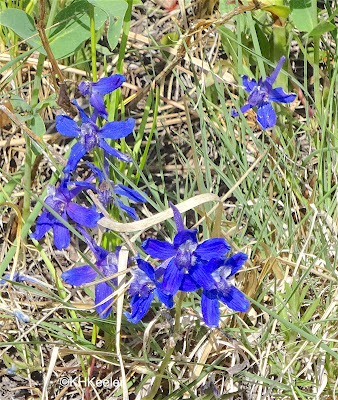 |
| Sheep Meadow, Rocky Mountain National Park |
We stayed at home from March 14 to May 31, 2020. Rocky Mountain National Park was closed then, in part to reduce crowds that might bring the corona virus to the nearby towns. One of Colorado's early lessons in the Covid-19 pandemic was that clinics in mountain towns have very small ICU (Intensive Care Units) and are easily overwhelmed. By late May, Colorado was reopening and Rocky Mountain National Park announced its own reopening, with a new daily entry pass required, free ($2 service charge and normal entrance fees), available online, but in limited numbers, to manage crowds. We booked a hotel we knew (Woodlands on Fall River) that has cabins with separate entrances. And off we went for three midweek days.
 |
| Sprague Lake |
We were there just before the new system went into effect, so we immediately drove into the park. Trail Ridge Road over the top of the park was still closed, not because it was impassable, but waiting for the entry pass to begin, June 4. At Sprague Lake, there were probably half the people of a busy summer day, but social distancing is difficult on trails and not everyone wore masks. On the south side of the lake, volunteers were warning that two elk cows were nearby and had charged some of the visitors, protecting newborn calves. I turned back, not completing the circuit. Partly I don't need the adrenaline rush of being charged by a large animal. I don't know how likely that was, but I also considered the problem from the elk's point of view--they were concerned about their calves and continually finding humans close by made them anxious. I could not decide whether my right to walk wherever I felt like in the National Park was more important than an animal's right to peace, but, for that particular day and walk, I decided it was no big deal to go back the way I came and not add to the elk mothers' worries.
People report that the animals are less timid, having had two months without much human visitation. However, elk have always wandered freely through the town of Estes Park, ignoring National Park boundaries, so I'm not sure two months changed much.
 |
| Elk in Estes Park October 2016 |
I did have the joy of watching a marmot grazing on the lawn of a cabin in Estes Park.
 |
| Marmot on the lawn, Estes Park, CO |
It was warm and nice. When the daily permit system started, we used the permit we'd gotten; entering the RMNP went very smoothly. We hiked easy trails. When what you want to see are flowers, no need to go up where the ground is still deep under snow.
This picture has golden banner (Thermopsis rhombifolia, pea family, Fabaceae) with the yellow flowers, and larkspurs (Delphinium species, there are several blue ones, buttercup family, Ranunculaceae). Golden banner spreads, forming clones. Larkspurs are small plants, not clonal.
 |
| larkspurs and golden banner |
Here's a larkspur close up, likely Nuttall's larkspur, Delphinium nutallianum. Isn't the color spectacular!
 |
| larkspur, Delphinium |
 |
| golden banner Thermopsis rhombifolia |
This iris is the Rocky Mountain iris, Iris missouriensis (iris family, Iridaceae). It was growing out in the meadow, not obviously in a wet area. Because it prefers moist areas, probably it had found a wet spot I couldn't see. (Missouri in the scientific name --iensis means "of Missouri"--refers to the Missouri River, not the state: this iris is not found in Missouri. See link )
 |
| Rocky Mountain iris, Iris missouriensis and big iridescent beetle. |
 |
| Carnation relative, likely mouse-ear |
We've been to Estes Park and Rocky Mountain National Park many times. This was a familiar place made unfamiliar by Covid-19 precautions. We had a three great days.

Comments and corrections welcome.
In case it isn't clear above, Estes Park is the town at the east entrance to Rocky Mountain National Park, it is not a park in the sense of a preserve or a green space within a town.
Kathy Keeler, A Wandering Botanist
More at awanderingbotanist.com
Join me on Facebook: https://www.facebook.com/AWanderingBotanist

No comments:
Post a Comment